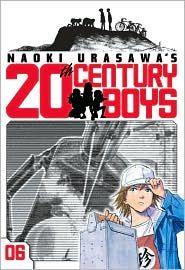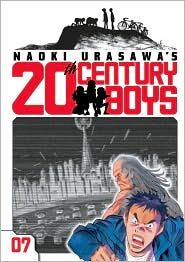While volume 5 remains the high point of Naoki Urasawa's 20th Century Boys, volumes 6 and 7 boldly forestall resolving the central mystery without sacrificing plot development or pacing.
For those of you just joining us, "20th Century Boys is about one's man struggle against a seemingly worldwide conspiracy to bring about the end of the world on December 31st, 1999. Kenji Endo's life is pretty much an exercise in unfulfilled expectations -- fast approaching 40 he's never managed to reach any of his potential. However, he may just be a born leader, a skill that comes in handy when he starts to uncover evidence of a mysterious plot to bring about terrifying incidents of death and devastation leading up to an apocalyptic finish at the dawn of the millennium." (From my review of volumes 4 and 5).
(Warning about spoilers: I reference events from volume 5 freely, so you might want to skip if you haven't yet read it. However, I try to be as vague as possible about events from volumes 6 and 7).
S
P
O
I
L
E
R
S
And I can't help but start off by slipping in yet another quote from my review of volume 4 and 5:
"Volume 5 returns to the focus to Japan and charts the rapid-fire events that lead up to what is supposed to be the climactic moment of December 31st, 1999 but instead ends up being one of the biggest mysteries of the story. Urasawa very deftly defies convention by not showing the reader what happens. Instead the second half the volume reveals the aftermath of the confrontation between Kenji's rag-tag group of resisters and the big evil afoot, but not the "why." It's a gutsy move that works and if I'm being exceptionally vague about what happens that is because I refuse to spoil the excitement and surprise of this volume."
The big reveal, which I didn't want to spoil in the previous review, was the flash forward to 2014, focusing on Kenji Endo's young niece, Kanna, now 17 years old in the storyline. Today, of course, this is a mere 4 years in the future, but in the world of 20th Century Boys the "future" is a big let down. It is neither post-apocalyptic nor utopian but a kind of seedy mess of "relative normality." It feels sort-of-but-not-quite like our reality and Kanna's adoration of her own personal version of Kenji and distrust of authority -- particularly police -- is intended to give us a queasy feeling that this world is not quite right in spite of the fact there is apparent "peace." In a brilliant twist, Kenji's become the very bad guy he once prophesied would appear, while the evil organization known only as the "Friends" have stepped in to become the saviors of the world.
In these volumes Urasawa expands out from Kanna's life to give us a broader picture of not only significant social institutions -- such as Japan's prison-industrial complex, police force, and public schools -- but also the story society tells itself about 1999's Bloody New Year's Eve and Kenji's reviled place in history. There's a great meta-ness to how Urasawa uses Kanna's classmate, who wants to write a history report on the infamous "terrorist" Kenji, and an imprisoned manga artist to question how we tell stories about ourselves and how those narratives construct our reality. In both instances, there's a strong sense that anyone who does follow the party line invites punishment -- if not outright death -- for somehow disturbing the strange stalemate of modern existence. Yet it isn't entirely clear who or what is so threatening to the "public order," or who is really pulling the strings.
The book continues to jump from scenes from Kenji's childhood, to Bloody New Year's
Eve -- the events of which are revealed only in flashback -- and 2014. As the book moves forward it becomes clear that the 20th Century Boys really belong to Kenji. He created them, inspired them, gave them purpose and without him there's a big gaping hole in the center of this work. It is surprising, though, that this is not a flaw of Urasawa's storytelling, since it allows us to see Kenji from multiple perspectives as key individuals reconnect and start to piece together what happened that fateful night. While it is painful to see Kanna become his biggest cheerleader now that he's an absence rather than a presence, her hero-worship of him becomes more and more understandable (if also terribly heart-breaking at the same time) as we see the various forms his heroism has taken over the years.
While I've always been excited by Urasawa's plotting-skills, with volume 6 and 7 of 20th Century Boys I've come to appreciate what an astounding job he's done with character-work in this title. For me, the biggest mystery of this title is becoming Kenji Endo and how exactly he became a man who could save the world.
Review copies provided by Viz.



